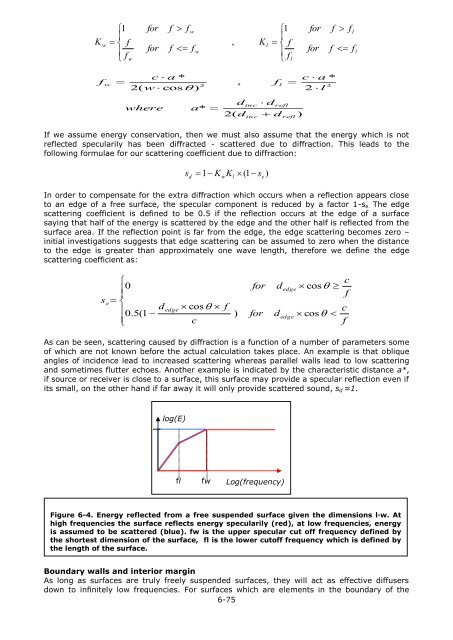Download - Odeon
Download - Odeon
Download - Odeon
Create successful ePaper yourself
Turn your PDF publications into a flip-book with our unique Google optimized e-Paper software.
K<br />
w<br />
1<br />
<br />
<br />
<br />
<br />
<br />
f<br />
f<br />
w<br />
for<br />
for<br />
f<br />
f<br />
<br />
<br />
f<br />
w<br />
f<br />
w<br />
,<br />
K<br />
l<br />
1<br />
<br />
<br />
<br />
<br />
<br />
f<br />
f<br />
l<br />
for<br />
for<br />
f f<br />
l<br />
f f<br />
l<br />
f<br />
w<br />
<br />
c a *<br />
2( w cos<br />
)<br />
2<br />
,<br />
f<br />
l<br />
<br />
c a *<br />
2<br />
2 l<br />
where<br />
a*<br />
<br />
d<br />
2( d<br />
inc<br />
inc<br />
d<br />
refl<br />
d<br />
refl<br />
)<br />
If we assume energy conservation, then we must also assume that the energy which is not<br />
reflected specularily has been diffracted - scattered due to diffraction. This leads to the<br />
following formulae for our scattering coefficient due to diffraction:<br />
s<br />
d<br />
1<br />
KwKl<br />
(1<br />
se<br />
)<br />
In order to compensate for the extra diffraction which occurs when a reflection appears close<br />
to an edge of a free surface, the specular component is reduced by a factor 1-s e. The edge<br />
scattering coefficient is defined to be 0.5 if the reflection occurs at the edge of a surface<br />
saying that half of the energy is scattered by the edge and the other half is reflected from the<br />
surface area. If the reflection point is far from the edge, the edge scattering becomes zero –<br />
initial investigations suggests that edge scattering can be assumed to zero when the distance<br />
to the edge is greater than approximately one wave length, therefore we define the edge<br />
scattering coefficient as:<br />
<br />
<br />
0<br />
se<br />
<br />
0.5(1<br />
<br />
<br />
d<br />
edge<br />
cos<br />
<br />
c<br />
f<br />
)<br />
for<br />
for<br />
d<br />
d<br />
edge<br />
edge<br />
cos<br />
<br />
cos<br />
<br />
c<br />
f<br />
c<br />
f<br />
As can be seen, scattering caused by diffraction is a function of a number of parameters some<br />
of which are not known before the actual calculation takes place. An example is that oblique<br />
angles of incidence lead to increased scattering whereas parallel walls lead to low scattering<br />
and sometimes flutter echoes. Another example is indicated by the characteristic distance a*,<br />
if source or receiver is close to a surface, this surface may provide a specular reflection even if<br />
its small, on the other hand if far away it will only provide scattered sound, s d ≈1.<br />
log(E)<br />
fl<br />
fw<br />
Log(frequency)<br />
Figure 6-4. Energy reflected from a free suspended surface given the dimensions l∙w. At<br />
high frequencies the surface reflects energy specularily (red), at low frequencies, energy<br />
is assumed to be scattered (blue). fw is the upper specular cut off frequency defined by<br />
the shortest dimension of the surface, fl is the lower cutoff frequency which is defined by<br />
the length of the surface.<br />
Boundary walls and interior margin<br />
As long as surfaces are truly freely suspended surfaces, they will act as effective diffusers<br />
down to infinitely low frequencies. For surfaces which are elements in the boundary of the<br />
6-75
















